The Evolution of Horror Stories
Horror stories have evolved over centuries, captivating audiences with their spine-chilling narratives. From ancient folklore to modern literature, these tales explore our deepest fears and the unknown. They offer a thrilling escape from reality, allowing readers to confront their anxieties in a safe environment.
Characteristics of Compelling Horror Tales
What distinguishes a great horror story? It often hinges on a few key elements. Firstly, the atmosphere plays a crucial role. A well-crafted setting can enhance the tension and immerse the reader in an eerie world. Secondly, relatable characters and complex emotions make the horror more impactful. Finally, effective pacing is essential; gradual build-up fosters suspense, leading to a climactic revelation that leaves readers breathless.
The Cultural Significance of Horror
Horror stories aren’t just entertaining; they serve a purpose in society. They can mirror cultural anxieties, addressing real-world issues through metaphorical monsters and haunting scenarios. This duality enriches the genre, making horror a form of social commentary as well as an exploration of human psychology. Whether it’s a creeping ghost story or a thrilling tale of survival, horror continues to resonate with diverse audiences, proving its timeless appeal.

